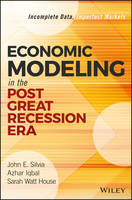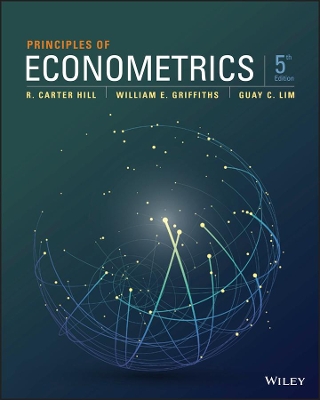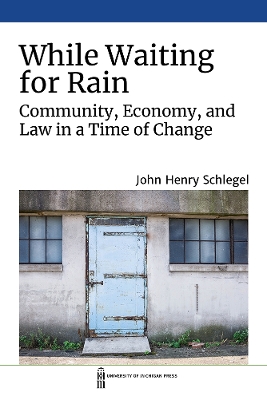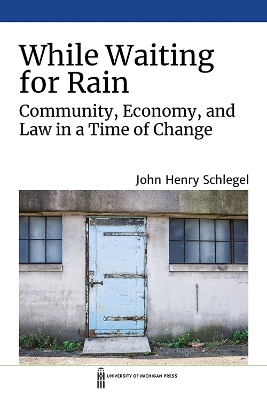Economic Modeling in the Post Great Recession Era
 -15%
portes grátis
-15%
portes grátis
Economic Modeling in the Post Great Recession Era
Incomplete Data, Imperfect Markets
House, Sarah Watt; Iqbal, Azhar; Silvia, John E.
John Wiley & Sons Inc
03/2017
400
Dura
Inglês
9781119349839
15 a 20 dias
604
Descrição não disponível.
Preface/Justification xiii
Acknowledgments xxi
Chapter 1 Setting the Context 1
The Problem with Uncritical Assumptions in a Less-Than-Perfect Economy 2
The Problem with Models in an Imperfect Economy 3
Four Characteristics of a Less-Than-Perfect Economy 4
Economic Policy Inconsistencies-The Parable of Strange Bedfellows 13
Chapter 2 Dynamic Adjustment in an Economy: Frictions Matter 15
Introduction 16
Quantifying Frictions: Is the Long-Run Average a Useful Guide for the Future? 32
Modeling Dynamic Adjustment due to Economic Frictions: Decision Making in an Evolving World 49
Dynamic Economic Adjustment: An Evolution unto Itself 67
Appendix 68
A Case for the Multiple Markets: 1983-2008 68
The Labor Market: 1983-2008 70
Chapter 3 Information: Past Imperfect, Present Incomplete, Future Uncertain 73
Story Behind the Numbers 76
Conclusion 103
Chapter 4 Price Adjustment and Search for Equilibrium 105
What Barriers Are There to Perfectly Flexible Prices? 107
Implications 112
Finding Dynamic Adjustment in the Data 116
Conclusion 121
Chapter 5 Business Investment: This Time Is Different 123
Drivers of Business Spending 125
Putting It All Together: Explaining Slow Recovery in Capital Investment 134
Chapter 6 Corporate Profits: Reward, Incentive, and That Standard of Living 135
Introduction: Profits as Essential Partner 136
The Role of Profits in the Economic Cycle: Five Drivers 137
The Role of Profits: Incentives and Rewards 140
Concluding Remarks: Modeling Profits 167
Chapter 7 Labor Market Evolution: Implications for Private-Sector and Public-Policy Decision Makers 169
Part I: Labor Market Imperfections 171
Part II: Heterogeneity in the Labor Market 182
Part III: How Do Secular Labor Market Trends Impact Economic Policy? 196
Chapter 8 Inflation: When What You Get Isn't What You Expect 205
Introduction 206
What Is Inflation? 207
Why Does Inflation Matter? 208
What Determines Inflation? 212
Inflation after the Great Recession 219
Application: Predicting if Central Banks Can Achieve Price Stability 230
Chapter 9 Interest Rates and Credit: Capital Markets in the Post-Great Recession World 235
Imperfect Guidance in an Uncertain World 236
A Look at Actual History over the Long Run 247
Credit and Administered Rates 250
Imperfect Information and Credit 255
Conclusion: Shift from Historical Benchmarks 280
Chapter 10 Three-Dimensional Checkers: Open Economy, Capital Flows, and Exchange Rates 281
Newton's Third Law 282
Introducing a New Price to the Analysis: The Role of Exchange Rates 289
Three-Dimensional Checkers on an International Playing Field 295
A Perfect Model in an Imperfect World 298
Concluding Remarks: Future Looks Different 330
Chapter 11 Assessing Economic Policy in an Imperfect Economy 331
Generalized Policy Model 333
Rules and Reputation: Beyond Economic Benchmarks 338
Confronting Our Three Market Imperfections 340
Economic Policy in the Context of an Imperfect Economy 359
About the Authors 361
Index 363
Acknowledgments xxi
Chapter 1 Setting the Context 1
The Problem with Uncritical Assumptions in a Less-Than-Perfect Economy 2
The Problem with Models in an Imperfect Economy 3
Four Characteristics of a Less-Than-Perfect Economy 4
Economic Policy Inconsistencies-The Parable of Strange Bedfellows 13
Chapter 2 Dynamic Adjustment in an Economy: Frictions Matter 15
Introduction 16
Quantifying Frictions: Is the Long-Run Average a Useful Guide for the Future? 32
Modeling Dynamic Adjustment due to Economic Frictions: Decision Making in an Evolving World 49
Dynamic Economic Adjustment: An Evolution unto Itself 67
Appendix 68
A Case for the Multiple Markets: 1983-2008 68
The Labor Market: 1983-2008 70
Chapter 3 Information: Past Imperfect, Present Incomplete, Future Uncertain 73
Story Behind the Numbers 76
Conclusion 103
Chapter 4 Price Adjustment and Search for Equilibrium 105
What Barriers Are There to Perfectly Flexible Prices? 107
Implications 112
Finding Dynamic Adjustment in the Data 116
Conclusion 121
Chapter 5 Business Investment: This Time Is Different 123
Drivers of Business Spending 125
Putting It All Together: Explaining Slow Recovery in Capital Investment 134
Chapter 6 Corporate Profits: Reward, Incentive, and That Standard of Living 135
Introduction: Profits as Essential Partner 136
The Role of Profits in the Economic Cycle: Five Drivers 137
The Role of Profits: Incentives and Rewards 140
Concluding Remarks: Modeling Profits 167
Chapter 7 Labor Market Evolution: Implications for Private-Sector and Public-Policy Decision Makers 169
Part I: Labor Market Imperfections 171
Part II: Heterogeneity in the Labor Market 182
Part III: How Do Secular Labor Market Trends Impact Economic Policy? 196
Chapter 8 Inflation: When What You Get Isn't What You Expect 205
Introduction 206
What Is Inflation? 207
Why Does Inflation Matter? 208
What Determines Inflation? 212
Inflation after the Great Recession 219
Application: Predicting if Central Banks Can Achieve Price Stability 230
Chapter 9 Interest Rates and Credit: Capital Markets in the Post-Great Recession World 235
Imperfect Guidance in an Uncertain World 236
A Look at Actual History over the Long Run 247
Credit and Administered Rates 250
Imperfect Information and Credit 255
Conclusion: Shift from Historical Benchmarks 280
Chapter 10 Three-Dimensional Checkers: Open Economy, Capital Flows, and Exchange Rates 281
Newton's Third Law 282
Introducing a New Price to the Analysis: The Role of Exchange Rates 289
Three-Dimensional Checkers on an International Playing Field 295
A Perfect Model in an Imperfect World 298
Concluding Remarks: Future Looks Different 330
Chapter 11 Assessing Economic Policy in an Imperfect Economy 331
Generalized Policy Model 333
Rules and Reputation: Beyond Economic Benchmarks 338
Confronting Our Three Market Imperfections 340
Economic Policy in the Context of an Imperfect Economy 359
About the Authors 361
Index 363
Este título pertence ao(s) assunto(s) indicados(s). Para ver outros títulos clique no assunto desejado.
economic modeling; economic forecasting; economic behaviors; SAS; recovery modeling; post-recession modeling; labor market modeling; economic characteristics; applied economics; economic indicators; modeling dynamic adjustment; modeling pricing lags; post-recession economic data; economic analysis; modeling markets; quantifying market behaviors; statistical modeling; SAS modeling; economic behavior quantification; economic modeling textbook; Economic Modeling in the Post Great Recession Era: Incomplete Data, Imperfect Markets; John E. Silvia; Alex Meohring; Azhar Iqbal; Sarah House
Preface/Justification xiii
Acknowledgments xxi
Chapter 1 Setting the Context 1
The Problem with Uncritical Assumptions in a Less-Than-Perfect Economy 2
The Problem with Models in an Imperfect Economy 3
Four Characteristics of a Less-Than-Perfect Economy 4
Economic Policy Inconsistencies-The Parable of Strange Bedfellows 13
Chapter 2 Dynamic Adjustment in an Economy: Frictions Matter 15
Introduction 16
Quantifying Frictions: Is the Long-Run Average a Useful Guide for the Future? 32
Modeling Dynamic Adjustment due to Economic Frictions: Decision Making in an Evolving World 49
Dynamic Economic Adjustment: An Evolution unto Itself 67
Appendix 68
A Case for the Multiple Markets: 1983-2008 68
The Labor Market: 1983-2008 70
Chapter 3 Information: Past Imperfect, Present Incomplete, Future Uncertain 73
Story Behind the Numbers 76
Conclusion 103
Chapter 4 Price Adjustment and Search for Equilibrium 105
What Barriers Are There to Perfectly Flexible Prices? 107
Implications 112
Finding Dynamic Adjustment in the Data 116
Conclusion 121
Chapter 5 Business Investment: This Time Is Different 123
Drivers of Business Spending 125
Putting It All Together: Explaining Slow Recovery in Capital Investment 134
Chapter 6 Corporate Profits: Reward, Incentive, and That Standard of Living 135
Introduction: Profits as Essential Partner 136
The Role of Profits in the Economic Cycle: Five Drivers 137
The Role of Profits: Incentives and Rewards 140
Concluding Remarks: Modeling Profits 167
Chapter 7 Labor Market Evolution: Implications for Private-Sector and Public-Policy Decision Makers 169
Part I: Labor Market Imperfections 171
Part II: Heterogeneity in the Labor Market 182
Part III: How Do Secular Labor Market Trends Impact Economic Policy? 196
Chapter 8 Inflation: When What You Get Isn't What You Expect 205
Introduction 206
What Is Inflation? 207
Why Does Inflation Matter? 208
What Determines Inflation? 212
Inflation after the Great Recession 219
Application: Predicting if Central Banks Can Achieve Price Stability 230
Chapter 9 Interest Rates and Credit: Capital Markets in the Post-Great Recession World 235
Imperfect Guidance in an Uncertain World 236
A Look at Actual History over the Long Run 247
Credit and Administered Rates 250
Imperfect Information and Credit 255
Conclusion: Shift from Historical Benchmarks 280
Chapter 10 Three-Dimensional Checkers: Open Economy, Capital Flows, and Exchange Rates 281
Newton's Third Law 282
Introducing a New Price to the Analysis: The Role of Exchange Rates 289
Three-Dimensional Checkers on an International Playing Field 295
A Perfect Model in an Imperfect World 298
Concluding Remarks: Future Looks Different 330
Chapter 11 Assessing Economic Policy in an Imperfect Economy 331
Generalized Policy Model 333
Rules and Reputation: Beyond Economic Benchmarks 338
Confronting Our Three Market Imperfections 340
Economic Policy in the Context of an Imperfect Economy 359
About the Authors 361
Index 363
Acknowledgments xxi
Chapter 1 Setting the Context 1
The Problem with Uncritical Assumptions in a Less-Than-Perfect Economy 2
The Problem with Models in an Imperfect Economy 3
Four Characteristics of a Less-Than-Perfect Economy 4
Economic Policy Inconsistencies-The Parable of Strange Bedfellows 13
Chapter 2 Dynamic Adjustment in an Economy: Frictions Matter 15
Introduction 16
Quantifying Frictions: Is the Long-Run Average a Useful Guide for the Future? 32
Modeling Dynamic Adjustment due to Economic Frictions: Decision Making in an Evolving World 49
Dynamic Economic Adjustment: An Evolution unto Itself 67
Appendix 68
A Case for the Multiple Markets: 1983-2008 68
The Labor Market: 1983-2008 70
Chapter 3 Information: Past Imperfect, Present Incomplete, Future Uncertain 73
Story Behind the Numbers 76
Conclusion 103
Chapter 4 Price Adjustment and Search for Equilibrium 105
What Barriers Are There to Perfectly Flexible Prices? 107
Implications 112
Finding Dynamic Adjustment in the Data 116
Conclusion 121
Chapter 5 Business Investment: This Time Is Different 123
Drivers of Business Spending 125
Putting It All Together: Explaining Slow Recovery in Capital Investment 134
Chapter 6 Corporate Profits: Reward, Incentive, and That Standard of Living 135
Introduction: Profits as Essential Partner 136
The Role of Profits in the Economic Cycle: Five Drivers 137
The Role of Profits: Incentives and Rewards 140
Concluding Remarks: Modeling Profits 167
Chapter 7 Labor Market Evolution: Implications for Private-Sector and Public-Policy Decision Makers 169
Part I: Labor Market Imperfections 171
Part II: Heterogeneity in the Labor Market 182
Part III: How Do Secular Labor Market Trends Impact Economic Policy? 196
Chapter 8 Inflation: When What You Get Isn't What You Expect 205
Introduction 206
What Is Inflation? 207
Why Does Inflation Matter? 208
What Determines Inflation? 212
Inflation after the Great Recession 219
Application: Predicting if Central Banks Can Achieve Price Stability 230
Chapter 9 Interest Rates and Credit: Capital Markets in the Post-Great Recession World 235
Imperfect Guidance in an Uncertain World 236
A Look at Actual History over the Long Run 247
Credit and Administered Rates 250
Imperfect Information and Credit 255
Conclusion: Shift from Historical Benchmarks 280
Chapter 10 Three-Dimensional Checkers: Open Economy, Capital Flows, and Exchange Rates 281
Newton's Third Law 282
Introducing a New Price to the Analysis: The Role of Exchange Rates 289
Three-Dimensional Checkers on an International Playing Field 295
A Perfect Model in an Imperfect World 298
Concluding Remarks: Future Looks Different 330
Chapter 11 Assessing Economic Policy in an Imperfect Economy 331
Generalized Policy Model 333
Rules and Reputation: Beyond Economic Benchmarks 338
Confronting Our Three Market Imperfections 340
Economic Policy in the Context of an Imperfect Economy 359
About the Authors 361
Index 363
Este título pertence ao(s) assunto(s) indicados(s). Para ver outros títulos clique no assunto desejado.
economic modeling; economic forecasting; economic behaviors; SAS; recovery modeling; post-recession modeling; labor market modeling; economic characteristics; applied economics; economic indicators; modeling dynamic adjustment; modeling pricing lags; post-recession economic data; economic analysis; modeling markets; quantifying market behaviors; statistical modeling; SAS modeling; economic behavior quantification; economic modeling textbook; Economic Modeling in the Post Great Recession Era: Incomplete Data, Imperfect Markets; John E. Silvia; Alex Meohring; Azhar Iqbal; Sarah House







